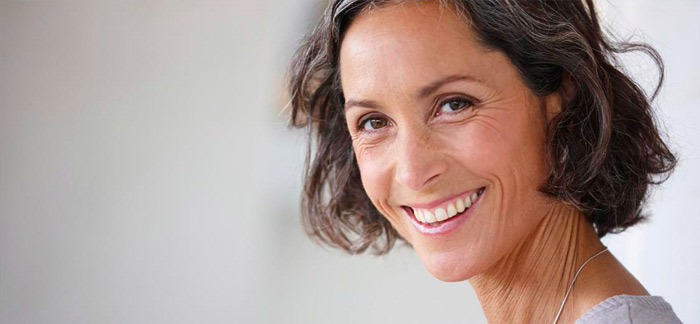
Despite what many women think, menopause is a natural process that shouldn’t be viewed negatively. In this normal transition, your body readjusts from one phase into the next. Every woman is unique; therefore, the menopause journey can’t be compared to someone else’s. Some women experience many symptoms, while others experience hardly any; some undergo menopause for a few months, whereas for others it may last a few years. How does one prepare for it?
What is it?

Between the ages of 35-55, a woman’s ovaries become smaller and stop producing estrogen and progesterone, the hormones controlling the menstrual cycle. After her eggs are no longer produced, ovulation stops, fertility decreases, and, eventually, after a year of not having had her cycle, it’s not possible to become pregnant anymore.
What happens?
There are four stages to menopause:
- Perimenopause (before) – this three- to five-year period before menopause (when your estrogen and hormone levels start dropping) typically occurs in your late forties. It’s still possible to become pregnant at this time, but this can be avoided by using birth control up until one year after your last menstrual cycle.
- Early menopause – aside from natural aging, other events can cause earlier menopause, such as a hysterectomy (removal of uterus), oophorectomy (removal of ovaries), or Premature Ovarian Failure (due to underactive or inactive ovaries, ovarian dysfunction or insufficient follicles which become eggs).
- Menopause (during) – most women are, on average, 51 or 52 years old when menopause starts. After you haven’t had your period for 12 consecutive months, without being ill, on medication, pregnant or breastfeeding, you’re said to be in menopause. The shift from stage one to three and four can take one to three years.
- Postmenopause (after) – this starts the year after your last menstrual cycle. It’s possible that other symptoms that may have started in stage one can continue throughout and after menopause. In this time, it’s quite common to experience perimenopause symptoms. You could also have an increased risk of heart disease, osteopenia and osteoporosis because of decreased estrogen.
When will it happen?
The following three case studies reveal how menopause is different for every woman:
Case study #1: Angelique*
Angelique (56) had a hysterectomy ten years ago due to adenomyosis. Two years later, she started experiencing hot flushes during the day, sleeplessness at night, and mood swings. “The gynae confirmed by a blood test that I was officially in menopause”, Angelique says. Since then, Angelique has taken a hormone replacement pill called Estrofem daily, and, at the age of 52, after a bone density scan, she was also diagnosed with osteoporosis. “A lot of people shy away from hormone replacement pills because of their side effects, but they could still be safe and beneficial, as they keep menopause symptoms at bay”, she shares. Now, Angelique takes one Estrofem every second day, and also does weight-bearing exercise to strengthen her bones, and will continue to have a bone density scan every three years. The worst of her symptoms have passed, and she hopes to phase out Estrofem next year.
Case study #2: Anna*
Anna (68), first noticed the symptoms of menopause when her cycle stopped at 55 years old. “It came back once after that, and then never again”, she says. Apart from moodiness, Anna experienced no pain or any other symptoms during menopause, and also took no medication. “Particularly over the last five years, my body temperature has become a lot colder”, she shares. Anna feels cold during the day, and wears an extra layer for warmth to cover the inside “chill”. About 15 years ago, a bone density test revealed osteopenia, and Anna still takes OsteoVite daily, along with walking for exercises and home aerobics, to help keep strong.

Case study #3: Frannie*
At 51 years old, Frannie’s monthly cycle started changing and became more erratic over more than one year. She experienced hot flushes day and night in the months of missing her cycle, which then evolved into night sweats. Frannie (54) has been taking the AIM Natural Progesterone cream since the age of 40, and still believes that natural supplements are better than artificial hormones, as there are no side effects. “Menopause is a time in one’s life when you ask a lot of questions about a lot of things. You consider your hopes and dreams and feel quite insecure”, she shares. “My menopause happened at the same time as a lot of life circumstances changed… it felt like everything was happening at once. Both my children left home in the same year, and it wasn’t easy. The most important thing for women in this time is friendship support and talking with your spouse”.
*not their real name
What can I do about it?

As your body is going through all of these changes, make sure you look after it and take care of yourself, by getting enough exercise, rest, and by eating good, healthy food. Smoking, alcohol, caffeine and stress is to be reduced as much as possible. Don’t be afraid to ask for advice or support - cultivate safe friendships and share your concerns. Try to spend as much time as you can outdoors, find new hobbies, and adopt a positive outlook; don’t stop hoping or dreaming about the future. Embrace this season of womanhood as you say goodbye to what is behind and look forward to what is ahead!
Date Published: 18 June 2018
